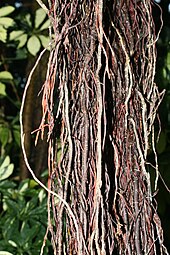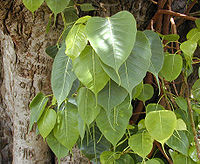Ficus
| Fig trees Temporal range:
| |
|---|---|

| |
| Sycamore fig, Ficus sycomorus | |
| Scientific classification | |
| Kingdom: | Plantae |
| Clade: | Tracheophytes |
| Clade: | Angiosperms |
| Clade: | Eudicots |
| Clade: | Rosids |
| Order: | Rosales |
| Family: | Moraceae |
| Tribe: | Ficeae Dumort.
|
| Genus: | Ficus L. |
| Species | |
|
About 800, see text | |
| Synonyms[1] | |
| |
Ficus (
Description


Ficus is a pantropical genus of trees, shrubs, and vines occupying a wide variety of ecological niches; most are evergreen, but some deciduous species are found in areas outside of the tropics and to higher elevations.[5] Fig species are characterized by their unique inflorescence and distinctive pollination syndrome, which uses wasp species belonging to the family Agaonidae for pollination.
Specific identification of many of the species can be difficult, but members of the genus Ficus are relatively easy to recognize. Many have aerial roots and a distinctive shape or habit, and their fruits distinguish them from other plants. The fruit of Ficus is an inflorescence enclosed in an urn-like structure called a syconium, which is lined on the inside with the fig's tiny flowers that develop into multiple ovaries on the inside surface.[6] In essence, the fig fruit is a fleshy stem with multiple tiny flowers that fruit and coalesce.
The unique fig
No unambiguous older
Some better-known species that represent the diversity of the genus include.alongside the
Moreover, figs with different plant habits have undergone
A description of fig tree cultivation is set out in Ibn al-'Awwam's 12th-century agricultural work titled, Book on Agriculture.[11]
Ecology
Figs are
Fig fruit and reproduction system

Many fig species are grown for their fruits, though only
The fruit typically has a bulbous shape with a small opening (the ostiole) at the outward end that allows access to pollinators. The flowers are pollinated by very small wasps that crawl through the opening in search of a suitable place to lay eggs. Without this pollinator service fig trees could not reproduce by seed. In turn, the flowers provide a safe haven and nourishment for the next generation of wasps. This accounts for the frequent presence of wasp larvae in the fruit, and has led to a coevolutionary relationship. Technically, a fig fruit proper would be only one of the many tiny matured, seed-bearing gynoecia found inside one fig – if you cut open a fresh fig, individual fruit will appear as fleshy "threads", each bearing a single seed inside. The genus Dorstenia, also in the fig family (Moraceae), exhibits similar tiny flowers arranged on a receptacle but in this case the receptacle is a more or less flat, open surface.[citation needed]
Fig plants can be
All the native fig trees of the American continent are hermaphrodites, as well as species like
When a caprifig ripens, another caprifig must be ready to be pollinated. In temperate climes, wasps hibernate in figs, and there are distinct crops. Caprifigs have three crops per year; common figs have two.) in the absence of caprifigs and fig wasps.
Depending on the species, each fruit can contain hundreds or even thousand of seeds.[18] Figs can be propagated by seeds, cuttings, air-layering or grafting. However, as with any plant, figs grown from seed are not necessarily genetically identical to the parent and are only propagated this way for breeding purposes.
Mutualism with the pollinating fig wasps

Each species of fig is pollinated by one or a few specialised wasp species, and therefore plantings of fig species outside of their native range results in effectively sterile individuals. For example, in Hawaii, some 60 species of figs have been introduced, but only four of the wasps that fertilize them, so only those species of figs produce viable seeds there and can become invasive species. This is an example of mutualism, in which each organism (fig plant and fig wasp) benefit each other, in this case reproductively.[citation needed]
The intimate association between fig species and their wasp pollinators, along with the high incidence of a one-to-one plant-pollinator ratio have long led scientists to believe that figs and wasps are a clear example of coevolution. Morphological and reproductive behavior evidence, such as the correspondence between fig and wasp larvae maturation rates, have been cited as support for this hypothesis for many years.[19] Additionally, recent genetic and molecular dating analyses have shown a very close correspondence in the character evolution and speciation phylogenies of these two clades.[7]
According to meta-analysis of molecular data for 119 fig species 35% (41) have multiple pollinator wasp species. The real proportion is higher because not all wasp species were detected.
The existence of cryptic species suggests that neither the number of symbionts nor
Systematics
With over 800 species, Ficus is by far the largest genus in the Moraceae, and is one of the largest genera of flowering plants currently described.
This traditional classification has been called into question by recent
Selected species
As of April 2024, there are 880 accepted Ficus species according to Plants of the World Online.[1]
Subgenus Ficus
- Ficus amplissima Sm. – bat fig
- Ficus caricaL. – common fig
- Ficus daimingshanensis Chang
- Ficus deltoidea Jack – mistletoe fig
- Ficus erecta Thunb. – Japanese fig
- Ficus fulva Reinw. ex Blume
- Ficus grossularioides Burman f. – white-leaved fig
- Ficus neriifolia Sm.
- Ficus palmata Forssk.
- Ficus pandurata Hance
- Ficus hirtaVahl)
- Ficus triloba Buch.-Ham. ex Voigt
Subgenus Pharmacosycea
- Ficus crassiuscula Standl.
- Ficus gigantosyce Dugand
- Ficus insipida Willd.
- Ficus lacunata Kvitvik
- Ficus maxima Mill.
- Ficus mutabilis Bureau
- Ficus nervosa Heyne ex Roth
- Ficus pulchella Schott
- Ficus yoponensis Desv.
Subgenus Sycidium
- Ficus andamanica Corner
- Ficus aspera G.Forst.
- Ficus assamica Miq.
- Ficus bojeri Baker
- Ficus capreifolia Delile
- Ficus coronata Spin – creek sandpaper fig
- Ficus fraseri Miq. – shiny sandpaper fig
- Ficus heterophylla L.f.
- Ficus lateriflora Vahl
- Ficus montana Burm.f. – oakleaf fig
- Ficus opposita Miq. – sweet sandpaper fig
- Ficus phaeosyce K.Schum. & Lauterb.
- Ficus tinctoria G.Forst. – dye fig
- Ficus ulmifolia Lam.
- Ficus wassa Roxb.
- Ficus parietalis
- Ficus sinuata
- Ficus hampelas
Subgenus Sycomorus
- Ficus auriculata Lour. – Roxburgh fig
- Ficus bernaysii King
- Ficus brusii Weiblen– lowland form of breadfruit, kapiak
- Ficus dammaropsis Diels – highland breadfruit, kapiak
- Ficus fistulosa Blume
- Ficus hispida L.
- Ficus nota Merr. – tibig
- Ficus pseudopalma Blanco
- Ficus racemosa L. – cluster fig
- Ficus septica Burm.f. – hauli tree
- Ficus sycomorus L., 1753 – sycamore fig (Africa)
- Ficus variegata Blume
Subgenus Synoecia
The following species[29] are typically spreading or climbing lianas:
- Ficus hederacea Roxb.[30]
- Ficus pantoniana King[31] – climbing fig
- Ficus pumila L.[32] – creeping fig
- Ficus pumila var. awkeotsang (Makino) Corner – jelly fig
- Ficus punctata Thunb.[33]
- Ficus sagittata J. König ex Vahl
- Ficus sarmentosa Buch.-Ham. ex Sm.
- Ficus trichocarpa Blume
- Ficus villosa Blume[34]
Subgenus Urostigma
- Ficus abutilifolia Miq.
- Ficus albert-smithii Standl.
- Ficus altissima Blume
- Ficus amazonica Miq.
- Ficus americana Aubl.
- Ficus aripuanensis Berg & Kooy
- Ficus arpazusa Carauta and Diaz – Brazil[35]
- Ficus aurea Nutt. – Florida strangler fig
- Ficus beddomei King – thavital
- Ficus benghalensis L. – Indian banyan
- Ficus benjamina L. – weeping fig[36]
- Ficus binnendijkii Miq.
- Ficus bizanae Hutch. & Burtt-Davy
- Ficus blepharophylla Vázquez Avila
- Ficus broadwayi Urb.
- Ficus burtt-davyi Hutch.
- Ficus calyptroceras Miq.
- Ficus castellviana Dugand
- Ficus catappifolia Kunth & Bouché
- Ficus citrifolia Mill. – short-leaved fig
- Ficus consociata Bl.
- Ficus cordata Thunb.
- Ficus costata Ait.[36]
- Ficus crassipes F.M.Bailey – round-leaved banana fig
- Ficus craterostoma Mildbr. & Burret
- Ficus cyathistipula Warb.
- Ficus cyclophylla (Miq.) Miq.
- Ficus dendrocida Kunth
- Ficus depressa Bl.
- Ficus destruens F.White
- Ficus drupacea Thunb.
- Ficus elastica Hornem. – rubber plant
- Ficus exasperata Vahl.
- Ficus faulkneriana Berg
- Ficus fergusonii (King) T.B.Worth. ex Corner
- Ficus glaberrima Blume
- Ficus glumosa Delile
- Ficus greiffiana Dugand
- Ficus hirsuta Schott
- Ficus ilicina Miq.
- Ficus kerkhovenii Valeton[37] – Johore fig
- Ficus kurzii King
- Ficus luschnathiana Miq.
- Ficus ingens Miq.
- Ficus krukovii Standl.
- Ficus lacor Buch.-Ham.
- Ficus lapathifolia Miq.
- Ficus lauretana Vázquez Avila
- Ficus lutea Vahl
- Ficus lyrata Warb. – fiddle-leaved fig
- Ficus maclellandii King – Alii fig
- Ficus macrophylla Desf. ex Pers. – Moreton Bay fig
- Ficus malacocarpaStandl.
- Ficus mariae Berg, Emygdio & Carauta
- Ficus mathewsii Miq.
- Ficus matiziana Dugand
- Ficus microcarpa L. – Chinese banyan
- Ficus muelleriana Berg
- Ficus natalensis Hochst. – Natal fig
- Ficus obliqua G.Forst. – small-leaved fig
- Ficus obtusifolia Kunth
- Ficus pakkensis Standl.
- Ficus pallida Vahl
- Ficus panurensis Standl.
- Ficus pertusa L.f.
- Ficus petiolaris Kunth
- Ficus pisocarpa Bl.
- Ficus platypoda Cunn. – desert fig
- Ficus pleurocarpa DC. – banana fig
- Ficus polita Vahl
- Ficus religiosa L. – sacred fig
- Ficus roraimensis Berg
- Ficus rubiginosa Desf. – Port Jackson fig
- Ficus rumphii Blume
- Ficus salicifolia Vahl – willow-leaved fig
- Ficus sansibarica Warb.
- Ficus schippii Standl.
- Ficus schultesiiDugand
- Ficus schumacheri Griseb.
- Ficus sphenophylla Standl.
- Ficus stuhlmannii Warb.
- Ficus subcordata Bl.
- Ficus subpisocarpa Gagnep.
- Ficus subpuberula Corner
- Ficus sumatrana Miq.
- Ficus superba Miq.
- Ficus superba var. henneana(Miq.) Corner
- Ficus thonningii Blume
- Ficus trichopoda Baker
- Ficus trigona L.f.
- Ficus trigonata L.
- Ficus triradiata Corner – red-stipule fig
- Ficus ursina Standl.
- Ficus velutina Willd.
- Ficus verruculosa Warb.
- Ficus virens Aiton – white fig
- Ficus virens var. sublanceolata (Miq.) Corner – sour fig
- Ficus watkinsiana F.M.Bailey – Watkins' fig
Unknown subgenus
Uses
The wood of fig trees is often soft and the
Figs have figured prominently in some human cultures. There is evidence that figs, specifically the
Cultivation
Numerous species of fig are found in cultivation in domestic and office environments, including:[40]
- F. carica, common fig – hardy to −10 °C (14 °F). Shrub or small tree which can be grown outdoors in mild temperate regions, producing substantial harvests of fruit. Many cultivars are available.
- F. benjamina, weeping fig, ficus – hardy to 5 °C (41 °F). Widely used as an indoor plant for the home or the office. It benefits from the dry, warm atmosphere of centrally-heated interiors, and can grow to substantial heights in a favoured position. Several variegated cultivars are available.
- F. elastica, rubber plant – hardy to 10 °C (50 °F): widely cultivated as a houseplant; several cultivars with variegated leaves
- F. lyrata, fiddle-leaf fig – hardy to 10 °C (50 °F)
- F. maclellandii – hardy to 5 °C (41 °F)
- F. microcarpa, Indian laurel – hardy to 10 °C (50 °F)
- F. pumila, creeping fig – hardy to 1 °C (34 °F)
- F. rubiginosa, Port Jackson fig – hardy to 10 °C (50 °F)
Cultural and spiritual significance
Fig trees have profoundly influenced culture through several religious traditions. Among the more famous species are the
-
Leaves of the sacred fig (Ficus religiosa)
-
Fig tree roots overgrowing a sandstone Buddha statue, nearAyutthaya province, Thailand
-
Ficus tree in front of Sarkaradevi Temple, Kerala, India
List of famous fig trees
- Ashvattha – the world tree of Hinduism, held to be a supernatural F. religiosa
- Bodhi tree– a F. religiosa
- , presumably a F. carica
- Curtain Fig Tree – a F. virens
- Ficus Ruminalis – a F. carica
- Plaksa– another supernatural fig in Hinduism; usually identified as F. religiosa but is probably F. virens
- Santa Barbara's Moreton Bay Fig Tree– a F. macrophylla
- Sri Maha Bodhi– another F. religiosa, planted in 288 BCE, the oldest human-planted tree on record
- Christian Bible, Jesus put a curse on the treeand used this as an example for believers of the promise of the power faith in the only true God.
- The Great Banyan – a F. benghalensis, a clonal colony and once the largest organism known
- Vidurashwatha – "Vidura's Sacred Fig Tree", a village in India named after a famous F. religiosa that until recently stood there
- Wonderboom – the largest fig tree in Pretoria, South Africa, which has grown very large, through self-layering(limbs laying in the ground take root).
Citations
- ^ a b "Ficus Tourn. ex L." Plants of the World Online. Royal Botanic Gardens, Kew. Retrieved 22 April 2024.
- ^ "ficus". Merriam-Webster.com Dictionary. Retrieved 2023-06-18.
- ISBN 978-0-37603-851-7.
- CollinsDictionary.com. HarperCollins.
- ISBN 978-0-8493-3916-5. Retrieved 2009-08-25.
- ^ "Ficus: The Remarkable Genus Of Figs". Archived from the original on 2009-12-11. Retrieved 2021-05-16.
- ^ a b c d e f g Rønsted et al. (2005).
- ^ Harrison (2005).
- ^ van Noort & van Harten (2006).
- ^ Berg & Hijmann (1989).
- –281 (Article XXV)
- ^ Armstrong, Wayne P; Disparti, Steven (4 April 1998). "A Key to Subgroups of Dioecious* (Gynodioecious) Figs Based On Fig Wasp/Male Syconium Pollination Patterns". Wayne's Word. Archived from the original on 2012-02-02. Retrieved 2012-01-05.
- ISBN 978-87-7304-304-2.
- PMID 28563939.
- ^ Berg & Corner (2005).
- ^ ISBN 978-0-12-227055-0.
- ^ California Rare Fruit Growers, Inc. (1996): Fig Archived 2020-10-31 at the Wayback Machine. Retrieved November 1, 2008.
- ^ "The Weird Sex Life of the Fig" (PDF). Ray's Figs. Retrieved 2012-01-05.
- PMID 11321056.
- PMID 25495152.
- PMID 15851680.
- ^ PMID 12714682.
- ISBN 978-0-87893-407-2.
- ^ PMID 10991904. Retrieved 2018-04-22.
- ^ Corner, E.J.H. (1965). "Check-list of Ficus in Asia and Australasia with keys to identification". The Gardens' Bulletin Singapore. 21 (1): 1–186. Retrieved 5 Feb 2014 – via biodiversitylibrary.org.
- ^ .
- ^ S2CID 1962136.
- ^ a b c d Rønsted et al. (2008).
- ^ Berg (2003).
- ^ Berg (2003), p. 552.
- ^ Berg (2003), p. 554.
- ^ Berg (2003), p. 553.
- ^ Berg (2003), pp. 565.
- ^ Berg (2003), pp. 553–554.
- ^ Carauta & Diaz (2002), pp. 38–39.
- ^ a b van Noort, S.; Rasplus, J.Y. (2020). "Subsection Conosycea". Figweb: figs and fig wasps of the world. Retrieved 11 August 2019.
- ^ Joseph Lai; Angie Ng; Chuah Ai Lin; Marilyn Cheng (12 September 2002). "Significant Trees and Shrubs in Changi". Retrieved 2012-01-05.
- ^ Castedo, Luis D. Leigue (1957). El Itenez Selvaje (PDF) (in Spanish). La Paz: Ministerio de Educación. p. 9, 16, 19, 23.
- ^ Kislev, Hartmann & Bar-Yosef (2006).
- ISBN 9781405332965.
- ^ Tukol, T.K. (1980). Compendium of Jainism. Prasaranga: Karnatak University. p. 206.
- ^ "The Bodhi Tree: Uniting all Worlds". Buddhists.org. Retrieved 17 January 2020.
General references
- Berg, C.C. (28 November 2003). "Flora Malesiana Precursor for the Treatment of Moraceae 4: Ficus subgenus Synoecia". Blumea. 48 (3): 551–571. .
- Berg, C.C.; Hijmann, M.E.E. (1989). "Chapter 11: Ficus". In R.M. Polhill (ed.). Flora of Tropical East Africa. pp. 43–86.
- Berg, C.C.; Corner, E.J.H. (2005). Flora malesiana. Series I, Seed plants. Volume 17. Part 2, Moraceae (Ficus). Leiden: National herbarium Nederland, Universiteit Leiden branch. OCLC 492578589.
- Carauta, Pedro; Diaz, Ernani (2002). Figueiras no Brasil. Rio de Janeiro: Editora UFRJ. ISBN 978-85-7108-250-2.
- OCLC 1086743649.
- Denisowski, Paul (2007). "Fig". Chinese–English Dictionary. Retrieved November 1, 2008.
- Harrison, Rhett D (2005). "Figs and the diversity of tropical rain forests" (PDF). BioScience. 55 (12): 1053–1064. .
- Kislev, Mordechai E.; Hartmann, Anat; Bar-Yosef, Ofer (2006). "Early Domesticated Fig in the Jordan Valley".
- Kislev, Mordechai E.; Hartmann, Anat; Bar-Yosef, Ofer (2006). "Response to Comment on "Early Domesticated Fig in the Jordan Valley"". S2CID 84471716.
- Lev-Yadun, Simcha; Ne'eman, Gidi; Abbo, Shahal; Flaishman, Moshe A (2006). "Comment on "Early Domesticated Fig in the Jordan Valley"". S2CID 45767896.
- Lewington, Anna; Parker, Edward (1999). Ancient trees: Trees that live for 1000 years. London: Collins & Brown. ISBN 978-18-5585-704-9.
- Rønsted, Nina; Weiblen, George D.; Cook, James M.; Salamin, Nicholas; Machado, Carlos A.; Savoainen, Vincent (2005). "60 million years of co-divergence in the fig-wasp symbiosis". PMID 16321781.
- Rønsted, N; Weiblen, G.D.; Clement, W.L.; Zerega, N.J.C.; Savolainen, V. (2008). "Reconstructing the phylogeny of figs (Ficus, Moraceae) to reveal the history of the fig pollination mutualism" (PDF). Symbiosis. 45. ISSN 0334-5114.
- Shanahan, M.; Compton, S. G.; So, Samson; Corlett, Richard (2001). "Fig-eating by vertebrate frugivores: a global review". S2CID 27827864. Electronic appendices
- van Noort, Simon; van Harten, Antonius (2006). "The species richness of fig wasps (Hymenoptera: Chalcidoidea: Agaonidae, Pteromalidae) in Yemen". Fauna of Arabia. 22: 449–472. Retrieved 2013-01-01.
External links
- Figweb—Major reference site for the genus Ficus
- World checklist of Ficus species from the Catalogue of Life, 845 species supplied by M. Hassler's World Plants.
- Video: Interaction of figs and fig wasps—Multi-award-winning documentary
- Fruits of Warm Climates: Fig
- BBC: Fig fossil clue to early farming
Video



